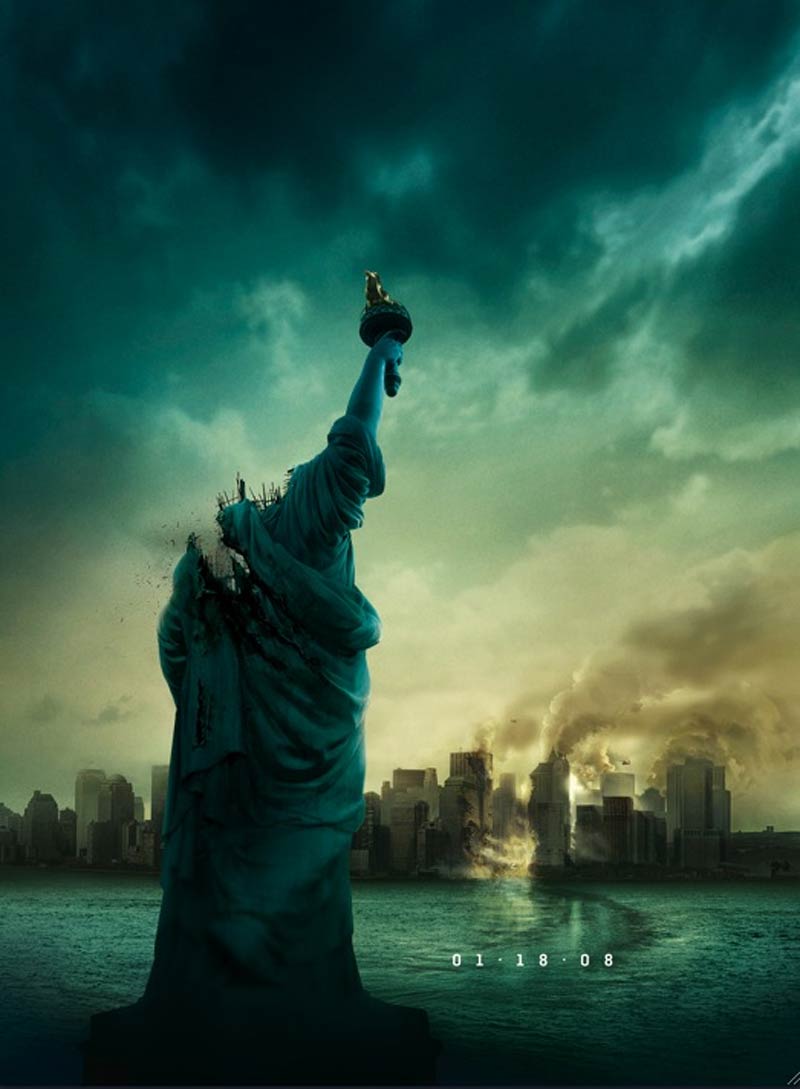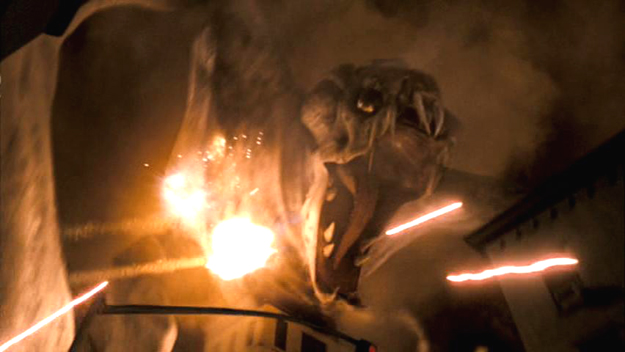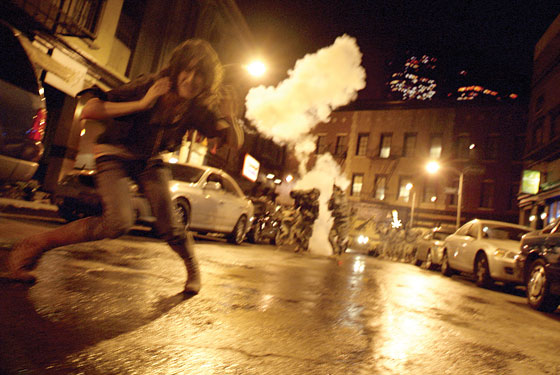Film is an entertainment medium that, by its very nature, tends to reward the viewer in rewatch. Sometimes movies even reveal to us how we’ve grown or changed since we last saw them. Our own Max Robinson reassesses old favorites, seasonal classics and the occasional oddball lost under the couch in his monthly column, Stale Popcorn.
About a week ago or so, we saw an interesting blip in the Movie Internet hype-sphere: A trailer for a previously unheard of Cloverfield semi-sequel dropped with zero fanfare before Michael Bay’s 13 Hours. It comes out this March. No one knew anything about 10 Cloverfield Lane and the trailer itself is pretty fucking compelling: You can’t deny the mesmerizing simplicity of John Goodman shaking his ass to Tommy James and the Shondells. At a point in time where we not only know the release dates for Marvel Studios movies years in advance and keep laundry lists of plot points we expect the next two Star Wars movies to check off, 10 Cloverfield Lane is an intriguing novelty, because it appears to be a totally unknown quantity. Which is ironic, because this is just a micro-variation on what happened in the lead up to Cloverfield. The film’s early marketing denied us any information on what the film would even be called, with posters simply stating the release date over the image of a decapitated Statue of Liberty. Eight years later, Cloverfield‘s sensationalist mysteries may be well-known to us but the film itself holds impressively well.
Thanks to the “puzzle box” showmanship of its marketing campaign, Cloverfield is more associated with its producer J.J. Abrams than it is director Matt Reeves. But in hindsight, watching the film, we see storytelling choices that end up employed to great effect in Reeves’s Dawn of the Planet of the Apes (my favorite film of 2014). Cloverfield the film is presented to the audience as recovered footage, the only obvious outside tampering being federal government disclaimer text describing the artifact. The text explains the footage was recovered from “the area formerly known as Central Park,” effectively and chillingly setting up the film in a manner somewhat reminiscent of the “virus footage” opening of Dawn. Cameras were an important visual indicator of loss and memory in Dawn — both Caesar the ape and Gary Oldman’s human survivor turn to audiovisual devices in times of personal turmoil — and Cloverfield leans heavily on camera recording as an important human act. Even before the movie gets into full-blown monster madness, we’re watching footage of a surprise going away party. The footage is specifically intended to be a gift for Rob (Michael Stahl-David), a 20-something who is moving to Japan.
Cloverfield grounds itself in Rob’s story, which feels surgically excised from the back third of a quirky romantic comedy. The implication is that Rob’s moving to Japan in large part because things got weird between him and formerly platonic friend Beth after they slept together. Cloverfield devotes about 15 minutes to the party sequence and it cleverly sets up the rest of the film. The looming threat of the end of Rob’s love life in America is completely consumed by the actual genuine threat of annihilation; his farewell party in honor of his exile to Japan is interrupted by a bonafide Kaiju. The pre-monster party sequence also introduces us to Rob’s brother’s girlfriend Lily (Jessica Lucas), erstwhile cameraman Hud (future Silicon Valley star T.J. Miller) and Marlena (future Masters of Sex star Lizzy Caplan). Hud, whose name is almost certainly a play on words, nurses an obvious crush on the aloof Marlena but only manages to annoy her in his clumsy attempts to get to know her. We’re given flashes of Rob and Beth’s obviously complex relationship thanks to “old” footage on the tape, and we see Hud and Marlena develop a fleeting platonic bond before they are both gruesomely killed.
First and foremost, Cloverfield commands its audience with some surprisingly sophisticated visual choices. The severed head of the Statue of Liberty skidding to a halt next to our heroes is perhaps a tad convenient but it’s both an homage to a similarly minded classic of sci-fi filmmaking and a to-the-point metaphor for the destruction of New York that unfolds over the film’s 85 minutes. Importantly, our glimpses of the nameless rampaging monster of Cloverfield are incredibly restrained; the scale of the creature seems impossible to fully capture on camera. For most of the film, the monster is in constant motion and obscured by debris or buildings. Its multi-limbed body almost doesn’t even seem anatomically consistent from scene to scene.
As the viewer, the disorientation we feel when we see quick glimpses of the creature or even when the camera shakes or spins is evocative of the anxiety and confusion experienced by the film’s protagonists. There’s a sense of unreality in many of these scenes, like when a battalion of troops firing heavy weapons inexplicably appears behind Rob and company or when Rob and Lily climb through the tilted hallway of a semi-collapsed penthouse to rescue Beth. Although the film is sold to us as (fictional) documentary realism, the line between “found footage” and visual flair is appropriately blurry.
I was also impressed by how effectively Reeves imbues Cloverfield with genuine tension. There’s a kind of rollercoaster drop lurch in your stomach in the pause between the film’s dry disclaimer text and the first footage we see. The film throws a pretty incredible “scary movie” gag at us when the characters try to turn on the camcorder’s “night vision” setting in a dark subway tunnel. It’s only when the camera switches modes that the viewer (and Hud) can see the horrific bug monsters hunting them. Towards the end of the film, we watch as a Central Park horse-pulled carriage walks down an empty street sans driver or passengers.
Cloverfield really hinges on one major scene, and it’s one that is easy to overlook. Hud, having somehow escaped a helicopter crash that has left our surviving cast in Central Park, runs to grab the camera and finds himself nearly face to face with the monster of the film. Hud picks up the camera, holding it on the creature and giving the audience our only head-on view of it. “Cloverfield” stares straight into the camera and Hud, paralyzed by fear, keeps filming. As far as we know, the Cloverfield monster doesn’t possess any real intelligence, but its murder of Hud feels like a calculated act of retribution. Hud’s body lands in front of the fallen camera, which erratically shifts in and out of focus. Hud, who didn’t even want the job of recording the party earlier, dies recording the events of the night and acting as a kind of noble witness.
The importance of Hud’s sacrifice isn’t lost on Rob, who retrieves the camera and continues to film until he and Beth are in turn killed. Rob’s final act is to record Beth giving a kind of final will and testament, a callback to Hud’s earlier interrupted attempt to film a goodbye message from Beth at the party earlier that night. Cloverfield‘s final seconds of footage, depicting Rob and Beth enjoying a day at Coney Island a month earlier, leave us to wonder if there is a kind of salvation in the non-linear, immortal document of film.
Check out more Stale Popcorn by Max Robinson.







